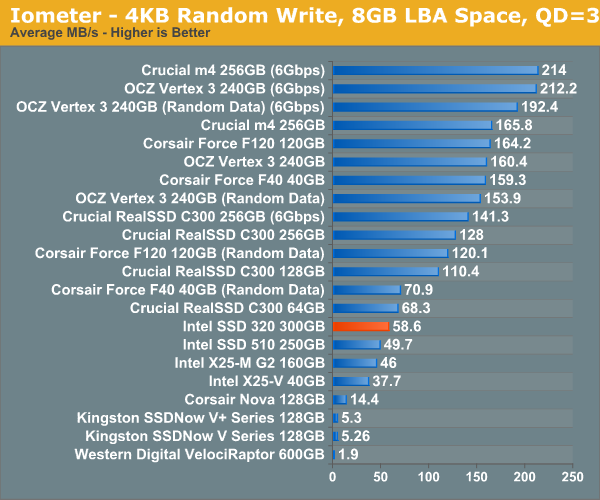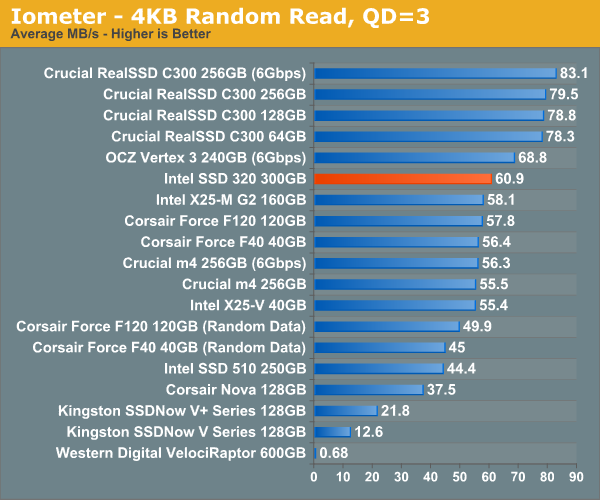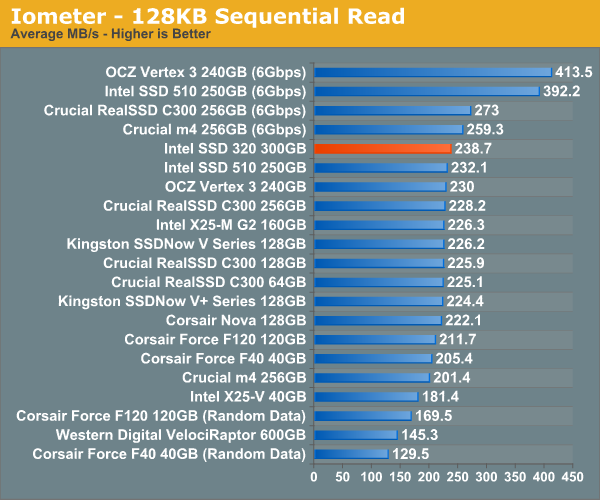The Intel SSD 320 Review: 25nm G3 is Finally Here
by Anand Lal Shimpi on March 28, 2011 11:08 AM EST- Posted in
- IT Computing
- Storage
- SSDs
- Intel
- Intel SSD 320
Random Read/Write Speed
The four corners of SSD performance are as follows: random read, random write, sequential read and sequential write speed. Random accesses are generally small in size, while sequential accesses tend to be larger and thus we have the four Iometer tests we use in all of our reviews.
Our first test writes 4KB in a completely random pattern over an 8GB space of the drive to simulate the sort of random access that you'd see on an OS drive (even this is more stressful than a normal desktop user would see). I perform three concurrent IOs and run the test for 3 minutes. The results reported are in average MB/s over the entire time. We use both standard pseudo randomly generated data for each write as well as fully random data to show you both the maximum and minimum performance offered by SandForce based drives in these tests. The average performance of SF drives will likely be somewhere in between the two values for each drive you see in the graphs. For an understanding of why this matters, read our original SandForce article.

Random write speed is improved compared to the 510 thanks to Intel's controller, but we're only looking at a marginal improvement compared to the original X25-M G2.
Many of you have asked for random write performance at higher queue depths. What I have below is our 4KB random write test performed at a queue depth of 32 instead of 3. While the vast majority of desktop usage models experience queue depths of 0 - 5, higher depths are possible in heavy I/O (and multi-user) workloads:


Random read performance has always been a strong point of Intel's controller and the 320 is no different. While we're not quite up to C300 levels, the 320 is definitely competitive here.
Sequential Read/Write Speed
To measure sequential performance I ran a 1 minute long 128KB sequential test over the entire span of the drive at a queue depth of 1. The results reported are in average MB/s over the entire test length.

Without a 6Gbps interface the 320's performance is severely limited. Compared to other 3Gbps drives the 320 is quite good here though.

Read performance is at the top of the chart for 3Gbps drives. I wonder how far Intel would've been able to push things if the 320 had a 6Gbps controller.










194 Comments
View All Comments
Ryan Smith - Monday, March 28, 2011 - link
Both the 120GB Vertex 2 and 300GB i320 are fully populated - each has all of their NAND channels in use. Intel does have a lane count advantage (10 vs. 8), but that's a design difference rather than how the SSD is populated. Thus on an architectural level it's fair to compare the controllers, as we're looking at the performance of both when they're fully populated and the architecture is not unnecessarily bottlenecked.Now at equal capacities this wouldn't necessarily be the case. Intel did not provide us with a smaller SSD, which is why Anand said "We also don't have a good idea of how much slower the smaller capacity drives perform in our benchmarks at this point.". It's safe to assume a 120GB i320 won't be fully populated and that it will have lower performance as a result. How much? We don't know.
crimson117 - Monday, March 28, 2011 - link
Thanks for the clarification! I appreciate your reply.I had missed the fact that each drive in the comparison has all its channels in use, so for example a 240GB SF-1200 would have higher capacity chips but would not have any additional channels to write across than a 120GB SF-1200.
Looking forward to the 120GB i320 review; it's much easier on the budget :)
ArteTetra - Monday, March 28, 2011 - link
i320? It sounds no good at all. Please call it with its name.GavinLeigh - Monday, March 28, 2011 - link
What we might have here is the kind of reliability (and hopefully pricing) to appeal to the notebook manufacturers. A 300Gb drive should be plenty for a road-warrior and the performance is definitely a plus over 7200rpm drives. Whole drive encryption could also add to the value in mobile applications.I think this is a smart drive, and I'll definitely consider it.
piquadrat - Monday, March 28, 2011 - link
How Full Disk Encription could add value in mobile applications when everyone can bypass ATA password within seconds using public available tools?DesktopMan - Monday, March 28, 2011 - link
See my response a page or two earlier. The password is used very differently for encrypted drives (that do cryptography correctly).tech6 - Monday, March 28, 2011 - link
While it won't win you bragging rights with your geek friends, the 320s do deliver something that has been missing from existing SSDs: Good enough performance, large capacities and reliability. The 1200 based drives had an unacceptable failure rate for most business/professional users and also couldn't deliver larger capacity drives. If the 2000 series comes in at the same price and is more reliable then Intel has problems and will need to discount but if its like the 1200 then Intel should sell a bunch of these.Chloiber - Monday, March 28, 2011 - link
I agree. The 320 is perfect for my notebook. Vertex 3 would be useless.y.a.k - Tuesday, March 29, 2011 - link
I agree. People say that it's a fail on Intel's part because it's slower than Vertex3. But I'm looking for an SSD for my work notebook, where reliability is even more important than speed. If this drive is as reliable as Intel says, then I'm getting it. And it's not like it's slow or anything.NCM - Tuesday, March 29, 2011 - link
Too many people seem to ignore that there are multiple markets for SSDs, and that they have different requirements beyond the basics. This leads to pointless discussions about the supposed merits of different SSD options. I see three main market segments, each with its own priorities:- Enterprise: Ultra high performance, and whatever you have to pay for that is simply the price of admission for your capacity and performance plan.
- Workstation: High performance boot/application drive, with the extra cost being quite moderate due to the relatively small size drive (~80-120GB) needed. Data can live on a secondary internal drive.
- Portable: Full capacity replacement for low performance standard drives. The typical single storage drive bay means that decent capacity at a reasonable $/GB is the key, not class leading performance.
(Note that reliability isn't a variable. I don't believe that any class of user will knowingly accept lower reliability than that offered by a conventional hard drive. Of course many have…unknowingly.)
This last category is the "good enough" requirement pointed out above by tech6. Sure, the Intel 320 may not be the most exciting new drive around, but notice that at $289 for 160GB or $599 for 300GB it's much less expensive than, say, the OWC Mercury Extreme at $599 for 160GB or—gasp!—$1619 for 400GB.
My own laptop drive is a 500GB with a over 300GB used, but with some housecleaning discipline I could live with the 300GB Intel. And in this application an SSD is like sex: even a bad SSD is good!
My Xserve uses an SSD boot/application drive, and I've set up one of our workstations similarly for evaluation. Boot and application launch times are, not surprisingly, 3-4 times faster with the SSD.